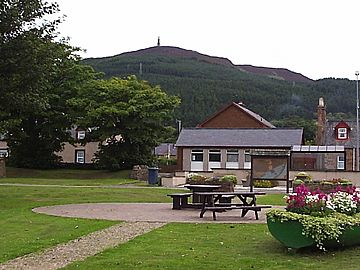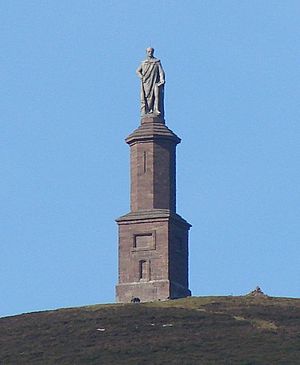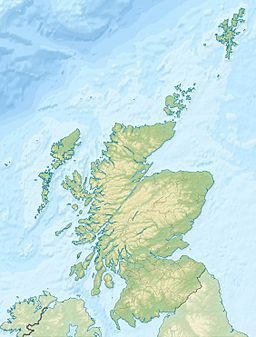Ben Bhraggie facts for kids
Quick facts for kids Ben Bhraggie |
|
|---|---|
| Beinn a' Bhragaidh | |

View of Ben Bhraggie from Golspie
|
|
| Highest point | |
| Elevation | 397 m |
| Parent peak | Beinn Lunndaidh |
| Geography | |
| OS grid | NC811010 |
| Topo map | OS Landranger 17, Explorer 441 |
Ben Bhraggie (Scottish Gaelic: Beinn a' Bhragaidh) is a well-known hill in Scotland. It stands tall at 397 meters (about 1,302 feet) above the sea. This hill is a famous landmark near the village of Golspie and can be seen from many places in eastern Sutherland.
On top of Ben Bhraggie, there's a huge 30-meter (100-foot) tall statue. It honors George Leveson-Gower, 1st Duke of Sutherland, who was a very important person in the history of the Highland clearances.
Contents
George Leveson-Gower and the Clearances
George Leveson-Gower was born in 1758. His father was the Marquess of Stafford. In 1785, he married Elizabeth, who was the daughter of the Earl of Sutherland. Elizabeth inherited the Earldom and its lands. This was unusual because it meant the title could pass through a female family member.
In the early 1800s, George and Elizabeth started big changes on their land in Sutherland. People have different ideas about why these changes happened. Some say George was worried about how his tenants lived. He believed the land couldn't support these farmers forever. So, he decided to move them to new villages along the coast. This would make space for large sheep farms inland.
Others believe he simply wanted to make more money. They think he decided it would be more profitable to use the land for sheep farming. This meant the tenants had to leave their homes, whether they wanted to or not.
Either way, these changes led to thousands of people being forced out of their homes and farms. This event was part of what is known as the Highland Clearances. During this time, it was common for the roofs of cleared houses to be burned. This stopped people from moving back in after they were evicted.
In 1819, many families were evicted. The burning of houses, combined with dry weather, led to a newspaper headline: "the Devastation of Sutherland." This year became known as "the year of the burnings." The Sutherland Clearances were probably the largest in the Highlands.
George's wife, the Countess of Sutherland, played a big role in managing the estate. This was unusual for the time. She visited the estate every year and wrote many letters about its management. George's main job was to provide the large amounts of money needed for these changes.
George Leveson-Gower became the first Duke of Sutherland in 1833. This was for his work in politics. He died a few months later in July 1833 at Dunrobin Castle. He was buried at Dornoch Cathedral.
In 1834, people started collecting money for a monument to remember him. Many people contributed, which might seem surprising given his reputation today. Work began quickly. The stone for the huge base was taken from Ben Bhraggie itself. The statue was made by Sir Francis Chantrey. It was taken up the hill in pieces by horse and cart. The monument was finished in 1837. It has been a major landmark in east Sutherland ever since. Locals often call it "the Mannie."
The Mannie: A Landmark and Its Story
The statue on Ben Bhraggie is known locally as "the Mannie." Over the years, some people have called for the statue to be removed or even torn down. It has been vandalized several times with graffiti. For example, the word "monster" was sprayed on it in green paint.

In November 2011, two large stone sections were pulled out from the statue's base. These sections were left lying on the grass. Later, more stones were removed from the base. Police believe there is an ongoing effort to try and topple the statue.
In 1995, a campaign was started to remove the statue. The idea was to put up a Celtic Cross or a plaque instead, to remember the victims of the Clearances. This campaign started a discussion about the statue that is still going on today. Despite the attempts to damage it, a BBC news report from 2011 said that many local people don't want the statue removed. They see it as an important reminder of history.
Fun on Ben Bhraggie: Sport and Arts
Ben Bhraggie is also a great place for outdoor activities. There's a network of mountain bike trails called the Highland Wildcat Trails. These trails go from the top of the hill down to Golspie village. They include challenging routes and one of the longest singletrack descents in the UK, which is about 7 kilometers long.
Ben Bhraggie is also mentioned in a well-known Scottish song called Granny's Hieland Hame.
See also
 In Spanish: Ben Bhraggie para niños
In Spanish: Ben Bhraggie para niños


